
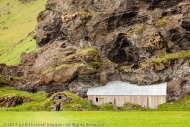
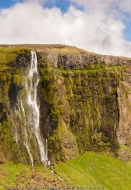
Last week in The Star Arrives! we welcomed the USCGC Polar Star into port at Hobart, Tasmania. This week we’ll take some of the officers to one devil of a zoo – or unzoo, as the case may be.
The Tasmanian Devil Unzoo is a unique wildlife nature exhibit and preserve located just a little over an hour from downtown Hobart, the capitol of Tasmania. It’s one of those must-see tourist destinations close to Hobart that I saved so I could share it with some Polar Star friends after their arrival.
First thing in the morning I drove up to Pier 6 and picked up my good friend Kara and whomever she happened to drag along that day. I always knew I’d have a car full of USCG and NOAA officers, I just never knew which ones. And off we went.
During my stay in Tasmania, I enjoyed some truly beautiful summer weather on most days. This was not to be one of them. It was raining, and continued to rain the entire day – not exactly the best way to experience an outdoor wildlife exhibit, but we were on a schedule. The ship was leaving in a couple of days, and we had things to do and places to visit, most of them outdoors. So we drove to the preserve, decked out in our best Seattle rain gear.
The Unzoo has an interesting mission that has morphed considerably since it’s inception. Originally, it was begun with the simple view of creating one of Tasmania’s first wildlife attractions. To that end, the Hamilton family bought the historic Brooklands farm, featuring 25 acres of apple and pear orchard and a run-down homestead, among other things, out on the Tasman Peninsula (which was to become an important detail years later). Their mission in 1978 was simple enough: to allow visitors to experience the fascinating animals and plants of Tasmania.
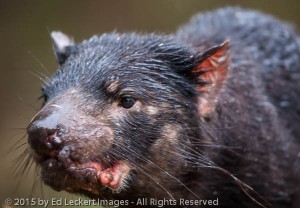
Due to their ferocious feeding habits, eating entire carcasses, bone and all, and frequently biting each other in the face in the process, Tasmanian Devils sport nasty wounds and scars on their faces, at the Tasmanian Devil Unzoo, Tasmania, Australia.
And fascinating they are. Tasmanian Devils, for example, are not the sort of animals you’d want living with you as pets, like cats, dogs, and skunks. No, these vicious little creatures provided the inspiration for “Taz” in the famous Warner Bros cartoons of the 1950s and 60s by their extremely bad table manners and even worse bedroom demeanor, emphasis on “mean”. They are scavengers, and when I say scavengers, I mean there will be nothing left when they’re done. They put lions and tigers and bears and vultures to shame. They eat the fur, the skin, the meat, and eventually the bone – all of it! And since they eat the whole carcass, they eventually meet in the middle – and just about bite each others faces off! And as for their sex habits, well, you don’t want to know – very un-PC to say the least. But they can be cute, as long as you look at them from their good side.
So in 1979, the Hamiltons opened their new exhibit as the Tasmanian Devil Park, with orphaned Tasmanian devils and other hand-raised and rehabilitated native animals on display. They began a successful devil breeding program and introduced what they called Devils in the Dark tours to allow visitors to track and view wild Tasmanian devils in their natural habitat. They removed the old orchard to eliminate the need for pesticides and introduced a free-flight bird show (which I will find highly useful in 2015). So far so good.
Then in 1996, something very odd happened. The first case of Devil Facial Tumor Disease, or DFTD, was discovered elsewhere in Tasmania. In fact, it was Dutch wildlife photographer Christo Baars who took several pictures of devils with grotesquely disfigured faces at Mount William National Park, an area I had visited earlier in Tasmania’s north-east. He took these images to zoologist Nick Mooney, of the Tasmanian Government’s Nature Conservation Branch. No one had ever seen anything like it before. Since then the devil population at Mount William has been estimated to have plummeted by 80 per cent (as of 2009), which may explain why I didn’t see a single one there, or anywhere in the wild for that matter.
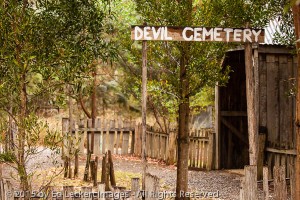
An area of the preserve is set aside as a cemetery, in the Tasmanian Devil Unzoo, Tasmania, Australia.
DFTD is a horrible disease. The animals suffer terribly, essentially starving to death within 3-8 months of showing symptoms due to their inability to feed once the cancerous tumors reach a certain size. But in the meantime, they continue to behave normally, and that includes biting each other during feeding and sex. And here’s the really weird part – the cancer is contagious!
Devil Facial Tumor Disease is only one of two known contagious cancers in the world. It turns out that the chromosomal arrangement of the cancer cells is different from a “conventional” cancer cell, and the infectious DFTD cell line is passed between devils through their feeding and biting behavior.
OK, that’s more than you wanted to know about disfigured devils, so back to the Unzoo. As the disease spread throughout all of Tasmania, the Unzoo realized that they were to play a pivotal role if the devils were to be saved from extinction. For starters, they already had a successful devil breeding program. But it was their location on the peninsula that was the key. Notice on the map how they are situated on the peninsula (the yellow star), which is separated from the main island by a really narrow land feature called Eaglehawk Neck? (The map is dynamic, so go ahead and zoom in to see for yourself. I’ll wait.) Well, it turns out that the neck is a fairly efficient filter to keep out diseased devils. So all they have to do is keep the healthy devils breeding and keep them from getting killed.
And therein lies another problem. As scavengers, devils like nothing more than to let the automobiles in the area do their killing for them. So, at night when all the wallabies come out into the highway to play chicken with cars, the devils are ready and waiting to come out and feed on the dead wallabies – and often become roadkill themselves. As a result, all of the Unzoo employees are required to carry roadkill removal devices (shovels) in their vehicles, and on their way to and from work, they scoop the dead wallabies off the road.
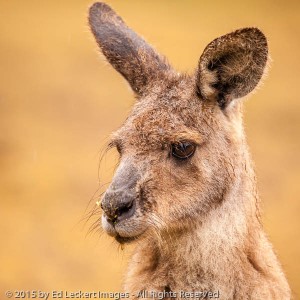
A Forester Kangaroo relaxes after being hand-fed by tourists, at the Tasmanian Devil Unzoo, Tasmania, Australia.
Besides devils, the Unzoo has quite a collection of other species. For example, they have yard where Forester Kangaroos hang out, and at feeding time tourists are allowed to hand-feed the critters. Now if you’ve seen the hilarious video of kangaroos kicking each other down the street near Sydney, you’re probably thinking that letting visitors hand-feed your kangaroos is not the brightest idea one could have had, unless eliminating tourists is your goal. (OK, I’m going to have to ponder that one for a bit.) But these are Tasmanian Forester Kangaroos, and they’re nothing like the brutes that inhabit the mainland. In fact, they’re downright polite! I guess it’s to make up for the behavior of the devils.
And then there’s the bird show. It was supposed to be outside, but due to the rain it was held in an open air shed. The keeper brought the birds out of their cages one at a time, describing their traits and putting on quite a show with one of them that could fetch coins from visitors’ fingers, and then return them!
And then of course the birds were supposed to go back into their cages. The problem was that the trainer was quite new, and the birds knew this, so after their performance, rather than obey the trainer, they took off out the door – first the cockatoo, then the little Eastern rosella. “Don’t worry, they’ll be back”, he said. “They know I’m new and they’re just messing with me.”
Well, while they were out enjoying some “air time”, I followed them out the door with my shiny new Canon EF 100-400mm f/4.5-5.6L IS II USM (Image Stabilized) Zoom Lens – that’s photographer-speak for big honkin’ telephoto zoom lens. I normally use a tripod, but that’s not possible when you’re chasing wildlife around a yard, so particularly with the darkened skies, I was grateful for the the image stabilization this baby provides – 4 stops of it, if you must know. That’s impressive, by the way. Thanks, Canon! And yes, I would love to give you the rest of my money, too!
OK, that about covers the zoo. Kara got some photos of me feeding the nice little roos, but they’re still in her camera on the Polar Star somewhere around Panama right now, so I don’t have them to show. Maybe next time!
